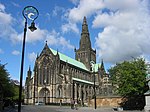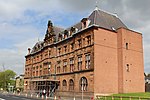Glasgow Necropolis
1832 establishments in ScotlandBuildings and structures in GlasgowCategory A listed buildings in GlasgowCemeteries in ScotlandCommonwealth War Graves Commission cemeteries in Scotland ... and 5 more
Inventory of Gardens and Designed LandscapesMonumental masonsNecropoleisTourist attractions in GlasgowUse British English from March 2017

The Glasgow Necropolis is a Victorian cemetery in Glasgow, Scotland. It is on a low but very prominent hill to the east of Glasgow Cathedral (St. Mungo's Cathedral). Fifty thousand individuals have been buried here. Typical for the period, only a small percentage are named on monuments and not every grave has a stone. Approximately 3,500 monuments exist here.
Excerpt from the Wikipedia article Glasgow Necropolis (License: CC BY-SA 3.0, Authors, Images).Glasgow Necropolis
Glasgow Garngad
Geographical coordinates (GPS) Address Nearby Places Show on map
Geographical coordinates (GPS)
| Latitude | Longitude |
|---|---|
| N 55.8625 ° | E -4.2305555555556 ° |
Address
G4 0UZ Glasgow, Garngad
Scotland, United Kingdom
Open on Google Maps









